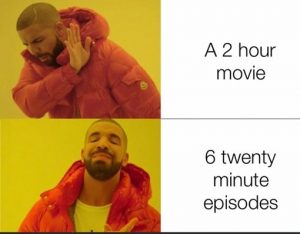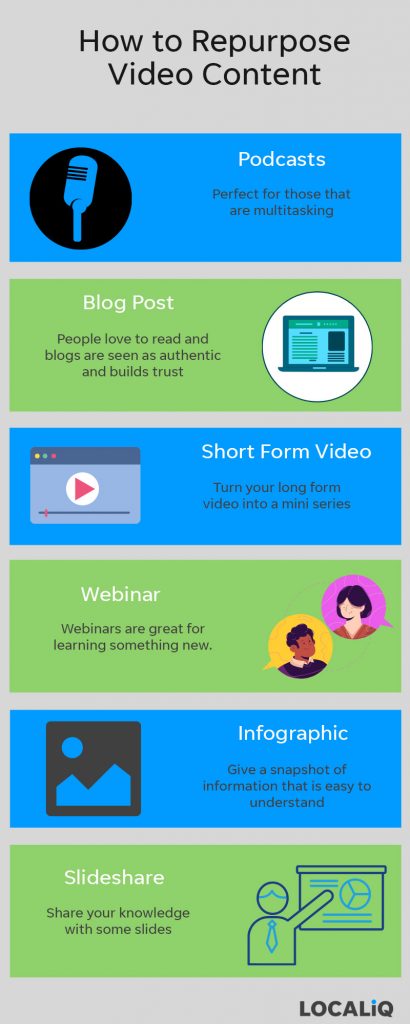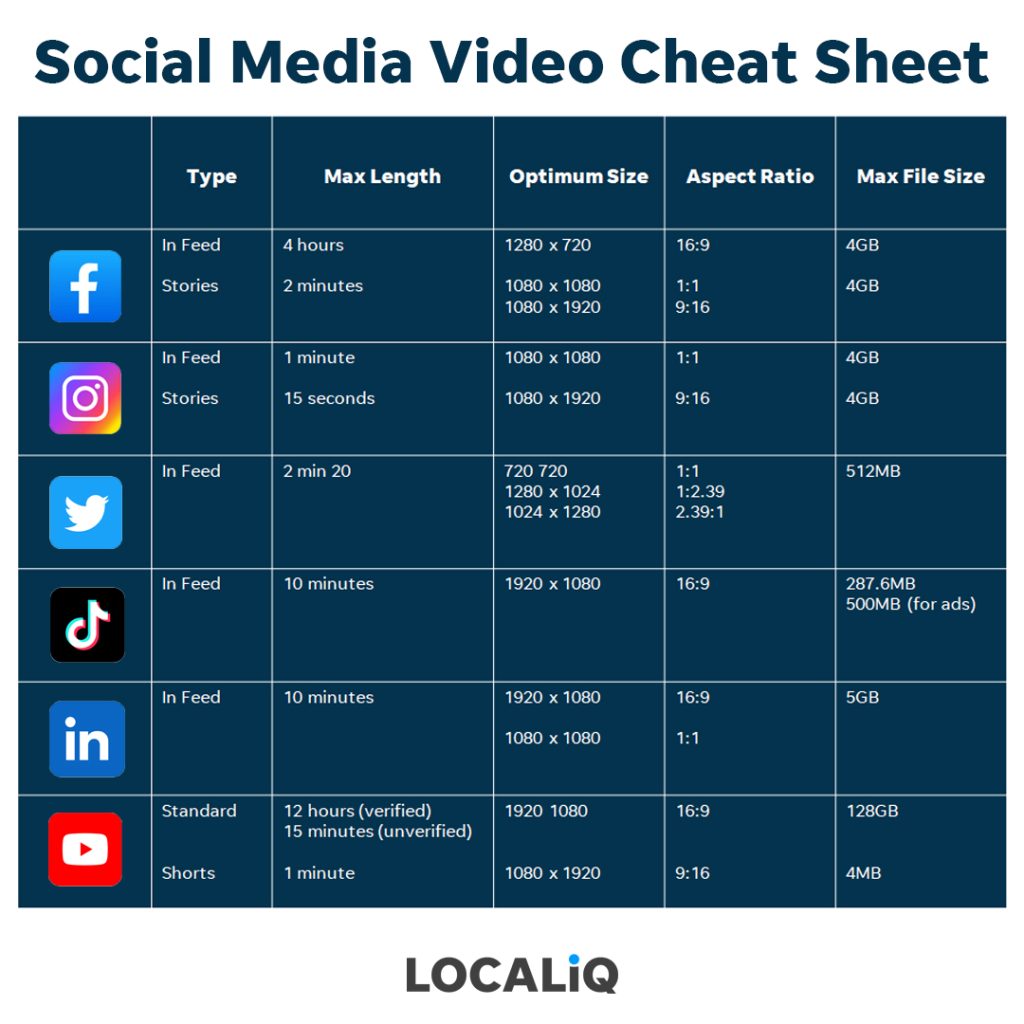You have spent ages creating a brilliant piece of video content but how do you ensure that the content has a long lifespan? By Repurposing the content, you will be able to reuse it in various forms, ensuring you get the maximum exposure and financial benefits from it.
In this blog, we will cover:
- Why is video content Important?
- Why should you repurpose video content?
- How to repurpose video content
- What does great repurposed content look like on social media?
Why is video content important?
Before we begin to divulge the secrets of repurposing content, we must look at why video content is important. Video content is a fantastic way for customers to gain an understanding of a product or service, however, it has many marketing purposes too:
- Viewers retain 95% of a message when they watch it in a video, compared to 10% when reading it in the text (Insivia).
- Marketers who use video grow revenue 49% faster than those who do not. (Wordstream)
- Video is 12 times more sharable than written content and images. (Small Biz Trends)
- Video gets 66% more marketing qualified leads. (Optinmonster)
- A video on a landing page can boost conversion rate by 80%. (Wordstream)
- 83% of marketers say that video has increased their time on page. (Wyzowl)
Why should you repurpose video content?
We know that making a video takes time and money. You need to come up with ideas, sometimes you need to add scripts, next is filming the video, and finally there is the editing. Repurposing allows you to optimise your marketing budget.
In addition, by creating multiple forms of content from one video, you can get your message across to a more diverse audience.
How to repurpose video content
From the impressive statistics above, you can see how important video content is from a marketing perspective. As marketers, we haven’t got the time to continually create video content; it is a time-intensive project using multiple resources, so we need to find ways to repurpose what we have.
Repurposing is simply recreating content in a variety of forms. This allows you to attract more people to your offerings. Let’s look at some ways in which we can repurpose our original video content:
How to repurpose video content into a podcast
While video is great, it is also demanding on the senses, requiring you to stop what you are doing, and watch and listen to it.
If you have produced a long form video, one simple thing to do is to turn the video’s audio into a podcast. Over 20% of people listen to a podcast weekly and is perfect for multitaskers; those commuting, doing housework, doing a workout, studying, and even working!
Podcasts have grown in popularity over the years, with over 19 million people in the UK listening to podcasts regularly.
The beauty of podcasts is that they allow you to target niche markets, so you get a more engaged audience. Your listeners feel connected to you when listening to your podcast. Podcasts are great for customers’ learning as audio helps people retain information.
There is plenty of software out there for you to transform video into a podcast. We recommend Audacity; a free open-source program allowing you to convert your file to MP3, with additional functionality such as enabling you to cut and edit your clip. You can upload your podcast to sites such as Soundcloud, Audible, Amazon Music, Google, Spotify, etc.
Are you a regular podcast listener? Why not take a look at our top 20 marketing podcasts?
How to repurpose video content into a blog post
You can connect to an audience in many ways, and blogging is still a trusted medium. Blogs help brands to build a connection with their audience, which in turn builds trust and loyalty.
Blogging allows businesses to increase their visibility. The more high-quality and helpful blogs a business creates the more chances they have of being found on SERPs (Search Engine Results Pages).
Blog posts are still exceedingly popular with 409 million people worldwide reading at least one blog per month and two blogs are published every second on the internet.
To repurpose your video into a blog, you can either transcribe your video or reword the video into a piece of written content.
Ensure you add plenty of bullet points to make the blog easy to read. You can even break the video down into a series of blog posts. Don’t forget to make the blog engaging by adding imagery or stills from your video (or embed small clips of video into your blog!)
How to repurpose video content into short-form videos
HubSpot compiled research that suggests that it is becoming increasingly hard to capture someone’s attention and that most people stop watching videos after about a minute. This meme perfectly sums up the perception of long-form and short-form video content.

Even if you captivate your audience from the start, they may lose interest. They could even see the length of a video and decide that is too long for them to watch!
You can turn your one long-form video into more bitesize chunks that you can share with your audience over several days, weeks, or even months. At the end of each video, you can get the audience to subscribe to be made aware when the next video in the series is released, which in return can grow your email subscribers too.
Short-form videos could also work well on TikTok, YouTube Shorts, or Instagram. Make sure to add a strong call to action to follow you for the next episode in the series. Alternatively, you could even upload the video series at once so people can binge-watch if they so choose.
How to repurpose video content into a webinar
Why not repurpose your content as an online webinar? Webinars are a great source for knowledge sharing.
By using the pre-existing content, your webinar can be less formal in tone and may even be longer than the original video form as you use your natural voice.
Free webinars are a fantastic way to attract new people to your website and your products and services.
You can turn some of the video content into slides and talk about each one. At the end of your webinar, you can send a copy of the slides and any other material you like to those who signed up for your webinar (even if they did not attend).
For hosting your webinar, we particularly like Go to Webinar.
How to repurpose video content into a SlideShare
A bonus one for those who repurposed their content as a webinar and used slides on there. Now use those slides again and create a SlideShare.
SlideShare’s are great for building knowledge, but you can do SlideShare’s about anything.
For example, a quick search on SlideShare had offerings such as Alan Rickman’s top 10 movie roles (spoiler: Snape beats Hans Gruber), best images of animals, to technology and social media. With plenty of topics, you will be able to find a place for your offering.
How to repurpose video content into an Infographic
These are popular ways of digesting information. When done correctly, infographics are visually pleasing and can present data, facts, knowledge, and information quickly and in a clear, understandable fashion. You can use an infographic as a standalone graphic or as part of a blog/webinar/social image.
Infographics with small bits of text are easier to read than going through paragraphs of information. For those of you who are not confident in the design, Canva has some free templates that can help you produce professional-looking graphics. The example below is something we quickly made on Canva to go with this blog:

What does great repurposed content look like on social media?
HubSpot noted that 54% of customers want to see more video content from brands they follow on social media. With that in mind, what factors do you need to consider when posting a video to social media?
You may have already shared a link to your long-form video on social media, but you can also break the video down into posts, reels (Instagram), stories and carousels.
There are several things to factor in when you want to post repurposed content on social media:
- With 85% of videos on social media watched without sound, ensure you include video captions to capture the audience’s attention. Additionally, videos with captions are accessible to those in the deaf community.
- You may need to alter the video dimensions and time limits as they differ across each platform. We have attached a cheat sheet to get you started on this blog.
- Social media sites prioritise content that is published natively on their site rather than content that links to a different site. To maximise your reach, post each video natively to each social networking site.
Did you know you can post videos up to 4 hours long on Facebook? As we said earlier though, nobody willingly watches a 4-hour video on social media! We suggest a short video of a few minutes long. You can post a video natively to Facebook, you can go live on Facebook, or you can post a 15-second video to Stories. For in-stream and live video, we recommend using landscape format, and for stories, use vertical format.
On Instagram, you have several options for video. A native video for up to 60 minutes, live video, stories (like Facebook these are for 15 seconds and in a vertical format) and lastly Reels (vertical again but for up to 1 minute long). For in-stream video, we recommend a square format of at least 600 x 600 pixels (although 1080 x 1080 would be even better). Your stories and reels are vertical videos.
TikTok
The video site has grown exponentially over the last few years and is much more than just dance crazes. TikTok has become one of the best social media sites for discovering and buying products with the ever popular #TikTokMadeMeBuyIt.
Originally, you could only post a 15-second-long video; nowadays, you can post up to 10-minute clips although the optimal video length is said to be between 21-34 seconds. A vertical format works best here.
You Tube
You have two options here, you can post longer form content onto YouTube in the traditional way, or you can use YouTube Shorts which allows users to upload 1 minute video. You can use Shorts as a way to entice viewers into your longer form content; giving users a tiny taste of your main content and adding a link to your full length video.
By following the suggestions in this blog, you can turn your 1 long-form video into multiple types of content across a multitude of sites, and appeal to more audiences which in turn increases the lifespan of your content.
At LOCALiQ we are passionate about video production and editing, and we have a dedicated team ready to help create a wonderful video for your customers to enjoy. If you want to know more about our video skills, visit our dedicated video production page. Alternatively, contact us today to see all how we can help you achieve your marketing goals.







